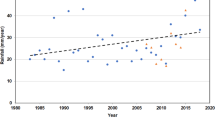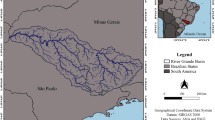Abstract
Basin morphometric parameters play an important role in hydrological processes, as they largely control a catchment’s hydrologic response. Their analysis becomes even more significant when studying runoff reaction to intense rainfall, especially in the case of ungauged, flash flood prone basins. Unit hydrographs are one of the useful tools for estimating runoff when instrumental data are inadequate. In this work, instantaneous unit hydrographs based on the time-area method have been compiled along the drainage networks of two small rural catchments in Greece, situated approximately 25 km northeast of its capital, Athens. The two catchments drained by ephemeral torrents, namely Rapentosa and Charadros, have been subject to flash flooding during the last decades, which caused extensive damages at the local small towns of Marathon and Vranas. Hydrograph compilation in numerous locations along the catchments’ drainage networks directly reflected the runoff conditions across each basin against a given rainfall. This gave a holistic assessment of their hydrologic response, allowing the detection of areas where peak flow rates were elevated and therefore, there was higher flood potential. The resulting flood hazard zonation showed good correlation with locations of damages induced by past flood events, indicating that the method can successfully predict flood hazard spatial distribution. The whole methodology was based on geographic information software due to its excellent capabilities on storing and processing spatial data.




Similar content being viewed by others
References
Alexander GN (1972) Effect of catchment area on flood magnitude. J Hydrol 16(3):225–240
Beven KJ, Wood EF, Sivapalan M (1988) On hydrological heterogeneity catchment morphology and catchment response. J Hydrol 100:353–375
Boglis A, Evelpidou N, Vassilopoulos A., Lekkas DF, Gournellos T, Fountoulis I (2009) Urban flood modeling in Karlovassi area—Samos Island, Greece. In: Proceedings of the 11th international conference on environmental science and technology, vol 1. Chania, Crete, 3–5 September 2009, pp 83–91
Brater EF, King HW (1976) Handbook of Hydraulics for the solution of hydraulic engineering problems. Mc Graw-Hill Book Company, New York
Candela A, Noto LV, Aronica G (2005) Influence of surface roughness in hydrological response of semiarid catchments. J Hydrol 313:119–131
Christofidis A (2008) Development of a GIS-based rainfall-runoff model. PhD thesis. Department of Water Resources and Environmental Engineering, Faculty of Civil Engineering, National Technical University of Athens
Clark CO (1945) Storage and the unit hydrograph. Trans ASCE 110:1419–1446
Davidson T (1880) The Dionysion at Marathon. Am J Philol 1:58–59
de Scally F, Slaymaker O, Owens I (2001) Morphometric controls and basin response in the Cascade Mountains. Geogr Ann 83(3):117–130
Diakakis M (2010) Flood history analysis and its contribution to flood hazard assessment. The case of Marathonas, Greece. Bull Geol Soc Greece 43:1323–1334
EEA (2000) Corine land cover. European Environment Agency, Commision of the European Communities, http://www.eea.europa.eu/publications/COR0-landcover Accessed:15 April 2010
Esper Angellieri MY (2008) Morphometric analysis of Colanguil river basin and flash flood hazard, San Juan, Argentina. Environ Geol 55:107–111
Fountoulis I, Mariolakos I, Andreadakis Emm, Sambaziotis E, Karagiozi E (2007) Strategic planning of anti-flood protection for Laconia Prefecture, App.2, In: Nikolaides et al. (ed) Antiflood protection master plan for Laconia prefecture, Environment, LIFE, EnviFriendly—Environmental Friendly Technologies for Rural Development, LIFE05 ENV/GR/000245, Prefecture of Laconia. http://www.evrotas.gr/archive.php. Accessed 25 July 2010
Greek Fire Department (2007) Emergency incidents in the Municipality of Marathonas, Greece. Department of Informatics and Communication, Greek Fire Department, Athens
Gupta V, Waymire E, Wang C (1980) A representation of an instantaneous unit hydrograph from geomorphology. Water Resour Res 16:855–862
Harlin JM (1984) Watershed morphometry and time to hydrograph peak. J Hydrol 67:141–154
Hellenic National Agricultural Insurance Organization (2007) Flood damages in municipality of Marathonas, Greece (1999–2008). Hellenic National Agricultural Insurance Organization Ministry of Rural Development and Food, Athens
IGME (2002) Kifissia sheet. Geological map of Greece series. Sheet 208, 1:50000, Athens, Institute of Geology and Mineral Exploration
Kilgore JL (1997) Developent and evauation of a GIS-based spatially distributed unit hydrograph model. Dissertation, Faculty of Virginia Polytechnic Institute, State University
Kirpich ZP (1940) Time of concentration of small agricultural watersheds. Civil Eng 10:362–368
Lastra J, Fernandez E, Diez-Herrero A, Marquinez J (2008) Flood hazard delineation combining geomorphological and hydrological methods: an example in the Northern Iberian Peninsula. Nat Hazards 45(2):277–293
Leake WM (1841) The topography of Athens and the Demi, vol 2, The Demi of Attica, 2nd edn. Gilbert and Rivington Printers, London. http://books.google.com/books. Accessed 25 March 2010
Maidment DR (1993) Developing a spatially distributed unit hydrograph by using GIS. HydroGIS 93: application of geographic information systems in hydrology and water resources, proceedings of the Vienna conference, April 1993) IAHS Publ. no 211
Maidment DR (2002) ArcHydro: GIS for water resources. ESRI Press, Redlands, California
Maidment DR, Olivera F, Calver A, Eatherall A, Fraczek W (1996) Unit hydrograph derived from a spatially distributed velocity field. Hydrol Process 10:831–844
Martini F, Loat R (2007) Handbook on good practices for flood mapping in Europe. European exchange circle on flood mapping (EXCIMAP), Paris/Bern. http://ec.europa.eu/environment/water/flood_risk/flood_atlas Accessed on 13 April 2010
Moussa R (2003) On morphometric properties of basins, scale effects and hydrological response. Hydrol Process 17:33–58
Muzik I (1996a) Flood modelling with GIS-derived distributed unit hydrograph. Hydrol Process 10:1401–1409
Muzik I (1996b) A GIS-derived distributed unit hydrograph. Proceeding of HydroGIS 96: application of geographic information systems in Hydrology and Water Resources Management, April 1996, Vienna, IAHS Publ. no. 235
Nunes JPC (2007) Vulnerability of mediterranean watersheds to climate change: the desertification context. PhD thesis, New University of Lisbon
Overton DE, Meadows ME (1976) Stormwater modeling. Academic press, New York
Pattison I, Lane SN, Hardy RJ, Reaney S (2008) Sub-catchment peak flow magnitude and timing effects on downstream flood risk. 10th National hydrology symposium, 15–17 September 2008 Exeter. http://www.hydrology.org.uk/Publications/exeter/44.pdf Accessed on 15 April 2010
Patton PC (1988) Drainage basin morphometry and floods. In: Baker VR, Kochel RC, Patton PC (eds) Flood geomorphology. Wiley-Interscience, New York, pp 51–64
Prefectural Administration of East Attica (2007) Flood damages (1987–2005). Athens: Technical Services Department, Prefectural Administration of East Attica
Rodriguez-Iturbe I, Valdes JB (1979) The geomorphologic structure of hydrologic response. Wat Resour Res 15(6):1409–1420
Rosmarakis S, Fonsos M (1999) Flood discharges assessment in drainage basins of East Attica in relation with land use changes. Dissertation, School of Rural and Surveying Engineering, National Technical University of Athens (In Greek)
Saghafian B, Farazjoo H, Bozorgy B, Yazdandoost F (2008) Flood intensification due to changes in land use. Water Resour Manag 22:1051–1067
Usul N, Yilmaz M (2002) Estimation of instantaneous unit hydrograph with Clark’s Technique in GIS, In: Proceedings of 2002 ESRI international user conference. ESRI on-line, San Diego. http://proceedings.esri.com/library/userconf/proc02
Vieux BE (2004) Distributed hydrologic modeling using GIS, 2nd edn. Kluwer Academic Publishers, Norwell, Massachusetts
Author information
Authors and Affiliations
Corresponding author
Rights and permissions
About this article
Cite this article
Diakakis, M. A method for flood hazard mapping based on basin morphometry: application in two catchments in Greece. Nat Hazards 56, 803–814 (2011). https://doi.org/10.1007/s11069-010-9592-8
Received:
Accepted:
Published:
Issue Date:
DOI: https://doi.org/10.1007/s11069-010-9592-8




